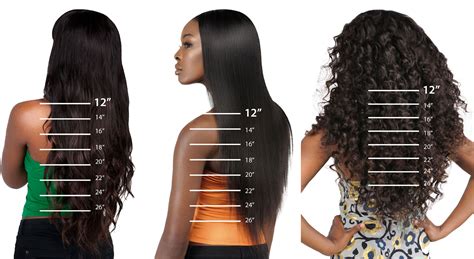Introduction
Achieving long, healthy 6-inch hair can be an ambitious pursuit, but with the right knowledge and care, it is entirely possible. This comprehensive guide will delve into the science, techniques, and tips essential for cultivating beautiful, 6-inch-long hair.

Growth Rate and Maintenance
- Natural Growth Rate: Hair grows at an average rate of 0.5 to 1.5 inches per month. To reach 6 inches, it takes approximately 4 to 12 months.
- Maintenance: Regular trimming (every 6-8 weeks) is crucial to prevent split ends and encourage healthy growth.
The Science of Hair Growth
Hair Follicles and Keratin
- Hair Follicles: Responsible for producing hair. Nutrients and oxygen are supplied through the blood vessels surrounding each follicle.
- Keratin: A protein that makes up 90% of hair. It provides strength and structure to the hair shaft.
Hair Growth Cycle
- Anagen Phase: Active growth phase that lasts 2-7 years.
- Catagen Phase: Transitional phase where growth stops.
- Telogen Phase: Resting phase that lasts 3-4 months, after which hair falls out and a new follicle forms.
Factors Influencing Hair Growth
Genetics
- Innate Hair Growth: Determined by genetic factors that influence the size, density, and growth rate of follicles.
Nutrition
- Protein Intake: Essential for hair growth, as keratin is a protein-based structure.
- Iron: Important for oxygen delivery to hair follicles.
- Vitamins A, C, and E: Act as antioxidants, protecting follicles from damage.
Hormones
- Testosterone: May promote hair growth in both men and women.
- Thyroid Hormones: Influence the growth cycle and hair thickness.
Stress and Environmental Factors
- Stress: Can temporarily suppress hair growth.
- Pollution: May damage hair follicles and inhibit growth.
Techniques for Promoting 6-Inch Hair
Scalp Massage
- Method: Using fingertips, gently massage the scalp in circular motions.
- Benefits: Improves blood circulation to the follicles, delivering nutrients and oxygen.
Hot Oil Treatments
- Method: Apply warm coconut or olive oil to the scalp and hair, covering with a warm towel.
- Benefits: Moisturizes and nourishes the hair, promoting shine and reducing breakage.
Deep Conditioning
- Method: Use a deep conditioner or hair mask as directed on the packaging.
- Benefits: Replenishes lost moisture, strengthens the hair shaft, and reduces tangles.
Avoid Heat and Chemical Treatments
- Heat: Excessive heat from blow dryers and styling tools can damage hair, leading to breakage.
- Chemical Treatments: Color treatments, bleach, and perms can weaken the hair structure.
Tips and Tricks for Growing 6-Inch Hair
- Brush Gently: Use a wide-toothed comb or detangling brush to prevent hair loss from breakage.
- Wash Regularly: shampoo and condition hair as needed, avoiding harsh or stripping products.
- Protect from the Elements: Wear hats or scarves when exposed to excessive sun or wind.
- Avoid Tight Hairstyles: Hairstyles that pull on the hair, such as tight braids or ponytails, can cause breakage.
- Get Enough Sleep: Sleep is essential for hormone production and overall hair health.
Step-by-Step Approach to 6-Inch Hair
- Set Realistic Goals: Determine a reasonable timeline for achieving your desired hair length.
- Establish a Hair Care Routine: Implement the techniques and tips discussed in this guide.
- Track Your Progress: Monitor your hair’s growth and adjust your routine as needed.
- Be Patient and Consistent: Hair growth takes time and consistency.
- Seek Professional Advice: If you encounter any hair growth issues, consult a dermatologist or trichologist.
Pain Points and Motivations
Pain Points
- Slow Growth: Natural hair growth can be slow and frustrating.
- Breakage and Damage: Hair can become brittle and prone to breakage due to various factors.
- Thinning and Shedding: Stress, poor diet, or hormonal imbalances can lead to hair loss.
Motivations
- Aesthetic Appeal: Long, healthy hair is often associated with beauty and femininity.
- Personal Confidence: Growing 6-inch hair can boost self-esteem and self-assurance.
- Hair Styling Versatility: Long hair allows for a wider range of hairstyles and creative expression.
Tables
Table 1: Factors Influencing Hair Growth
| Factor | Description |
|---|---|
| Genetics | Inherent hair growth potential |
| Nutrition | Availability of essential nutrients |
| Hormones | Thyroid and testosterone levels |
| Stress and Environmental Factors | Emotional and physical stress, pollution |
Table 2: Benefits of Hair Growth Techniques
| Technique | Benefits |
|---|---|
| Scalp Massage | Improved blood circulation, nutrient delivery |
| Hot Oil Treatments | Moisture and nourishment |
| Deep Conditioning | Replenished moisture, strengthened hair shaft |
Table 3: Hair Care Tips for 6-Inch Hair
| Tip | Purpose |
|---|---|
| Brush Gently | Prevent breakage |
| Wash Regularly | Maintain scalp and hair hygiene |
| Protect from the Elements | Prevent damage from sun or wind |
| Avoid Tight Hairstyles | Reduce breakage |
| Get Enough Sleep | Promote hormone production |
Table 4: Step-by-Step Approach to 6-Inch Hair
| Step | Description |
|---|---|
| Set Realistic Goals | Determine a reasonable timeline |
| Establish a Hair Care Routine | Implement recommended techniques and tips |
| Track Your Progress | Monitor hair growth and adjust routine |
| Be Patient and Consistent | Hair growth takes time and consistency |
| Seek Professional Advice | Consult a dermatologist or trichologist if needed |
Conclusion
Growing 6-inch hair is an achievable goal with the right combination of science, techniques, and unwavering dedication. By addressing pain points, understanding the science behind hair growth, and implementing the tips and tricks outlined in this guide, you can unlock the full potential of your hair. Embrace the journey, celebrate your progress along the way, and ultimately achieve the long, luscious locks you desire.
